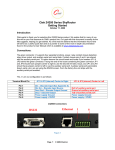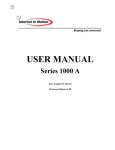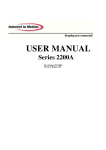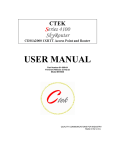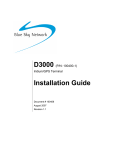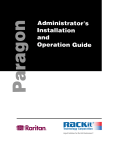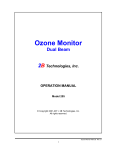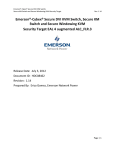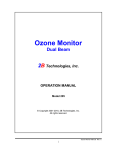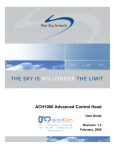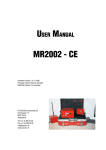Download USER MANUAL - Direct Communication Solutions
Transcript
USER MANUAL DCS Z Series Cellular Routers Models Z4200 and Z4400 . 26 March 2013 Table of Contents TABLE OF CONTENTS I TABLE OF FIGURES II PREFACE 1 1 INTRODUCTION 1 1.1 Theory Of Operation 1 1.2 Features 1 2 CONNECTORS, LIGHTS, SWITCHES, AND JUMPERS 2 2.1 Switches 2 2.2 Lights 3 2.3 Connectors (see Figures 2, 3 and 4 below) 3 3 START UP 5 3.1 Power 5 3.2 Connecting the Antenna 6 3.3 Connecting to the Ethernet Port – Administrative Connection 6 4 ADMINISTRATION, CONFIGURATION AND STATUS 6 4.1 7 Getting Started 4.2 Interfaces 4.2.1 Configuring The Wireless Interface 4.2.2 Configuring The Ethernet Interace 4.2.1 The RS232/RS485 Interface 4.2.2 Configuring The Relay Input Interface 4.2.3 Configuring The Relay Output (Driver) Interface 10 10 15 16 17 18 4.3 Status 4.3.1 Wireless Status 4.3.2 Ethernet Status 19 19 24 4.4 Services 4.4.1 Password Administration 4.4.2 Routing and Forwarding Services 25 25 25 i 26 March 2013 4.4.3 4.4.4 4.4.5 4.4.6 4.4.7 28 30 32 40 41 GRE Tunneling Services IPsec Services Serial Communications Services Admin Screen Services Wireless Activation Services (Z4200 CDMA Only) 4.5 Options 4.5.1 Applications 4.5.2 Tools 4.5.3 SIM Editor (Z4400 HSPA Only) 4.5.4 AT Commands (Z4400 HSPA Only) 45 45 45 46 47 5 SPECIFICATIONS 48 6 CERTIFICATIONS 48 7 APPENDIX A – DISCRETE I/O ELECTRICAL DRAWINGS 49 Table of Figures FIGURE 1 - LIGHTS AND SWITCHES ................................................................................................................................................... 3 FIGURE 2 - DB9 CONNECTOR ............................................................................................................................................................... 4 FIGURE 3 – Z4200S MODEL CONNECTORS ........................................................................................................................................ 5 FIGURE 4 – Z4200U MODEL CONNECTORS ....................................................................................................................................... 5 FIGURE 5 - WINDOWS CONFIGURATION .......................................................................................................................................... 6 FIGURE 6 - LOGIN SCREEN ................................................................................................................................................................... 7 FIGURE 7 - Z4200 TOP MENU ................................................................................................................................................................ 8 FIGURE 8 - Z4400 MENU ......................................................................................................................................................................... 9 FIGURE 9 - Z4200 TOP MENU WITHOUT ROUTING........................................................................................................................ 10 FIGURE 10 - Z4200 (CDMA) WIRELESS INTERFACE ...................................................................................................................... 11 FIGURE 11 - Z4200 NETWORK SELECT ............................................................................................................................................. 11 FIGURE 12 - Z4400 (HSPA) WIRELESS INTERFACE ........................................................................................................................ 13 FIGURE 13 - ETHERNET CONFIGURATION ..................................................................................................................................... 15 FIGURE 14 - RS232/485 CONFIGURATION ........................................................................................................................................ 16 FIGURE 15 - RELAY INPUT CONFIGURATION ................................................................................................................................ 17 FIGURE 16 - RELAY OUTPUT CONFIGURATION ............................................................................................................................ 19 FIGURE 17 - WIRELESS STATUS (Z4200) .......................................................................................................................................... 20 FIGURE 18 - WIRELESS STATUS DETAILS Z4200 ........................................................................................................................... 21 FIGURE 19 - WIRELESS STATUS Z4400 ............................................................................................................................................. 23 FIGURE 20 - ETHERNET STATUS ....................................................................................................................................................... 24 FIGURE 21 = PASSWORD ADMINISTRATION .................................................................................................................................. 25 FIGURE 22 - ROUTING AND FORWARDING .................................................................................................................................... 26 FIGURE 23 - ADVERTISING ................................................................................................................................................................. 27 FIGURE 24 - GRE TUNNELING CONFIGURATION .......................................................................................................................... 28 FIGURE 25 - A GRE TUNNEL ............................................................................................................................................................... 29 FIGURE 26 - IPSEC ADMINISTRATION ............................................................................................................................................ 30 FIGURE 27 - SERIAL COMMUNICATIONS MENU ........................................................................................................................... 32 FIGURE 28 - TCP PAD CONFIGURATION .......................................................................................................................................... 33 FIGURE 29 - UDP PAD CONFIGURATION ......................................................................................................................................... 38 ii 26 March 2013 FIGURE 30 - PPP CONFIGURATION ................................................................................................................................................... 39 FIGURE 31 - ADMIN SCREEN CONTROL .......................................................................................................................................... 40 FIGURE 32 - SPRINT ACTIVATION..................................................................................................................................................... 41 FIGURE 33 - VERIZON WIRELESS ACTIVATION ............................................................................................................................ 42 FIGURE 34 - ACTIVATION CONTROL ............................................................................................................................................... 42 FIGURE 35 - ACTIVATION LOG .......................................................................................................................................................... 43 FIGURE 36 - MANUAL ACTIVATION ................................................................................................................................................. 44 FIGURE 37 - SPRINT PRL UPDATE ..................................................................................................................................................... 45 FIGURE 38 - USER DEFINED APPLICATIONS .................................................................................................................................. 45 FIGURE 39 - SIM MANAGEMENT ....................................................................................................................................................... 46 FIGURE 40 - AT COMMAND INTERFACE ......................................................................................................................................... 47 iii 26 March 2013 Preface Welcome to the DCS Z Series Cellular Router User’s Guide. This manual covers the Z4200 EVDO and the Z4400 UMTS/HSPA router. The User’s Guide will explain the basic operation of the router and take you through the necessary settings to get your wireless application online. Additional information and applicable technical notices can be found at www.dcsbusiness.com. Note that all administrative functions and screens on the two models are identical with the exception of the Wireless Status and Wireless Interface screens, and the Z4200's Activation screen which is replaced on the Z4400 by a SIM Tools menu item. 1 Introduction Wireless routers provide application and network designers with a bridge between the world of IT infrastructure and the evolving wireless M2M networks. With the Z Series the wireless transport is fully integrated into the product’s routing fabric meaning that you can approach the setup and operation of this product much as with any other IP addressable device. Wireless considerations are reduced to the absolute minimum necessary to register and make connections on a network. A number of optional controllers are available for use with the models covered in this manual including a micro amp standby power controller, an analog/digital I/O controller, and a relay power controller. The operation of these devices is covered in their specific user manual and in applicable TechNotes. 1.1 Theory Of Operation The Z Series router is a complete IP router that routes traffic over LAN Ethernet (10/100baseT) connections. The wireless features of the router simply extend the IP routing capabilities to include routing and network address translation (NAT) over cellular wireless networks. As with most routers DCS’s Z Series can be viewed as having a Local Area Network (LAN) side and a Wide Area Network (WAN) side. Traffic originating at the router’s Ethernet or Serial port is considered LAN traffic. The Wide Area Network connection is over the wireless network’s bearer channel(s). 1.2 Features This manual covers DCS Z Series and contains the following feature and functions. 1) Ethernet a. Static Addressing b. Dynamic (DHCP) Server c. Configurable DNS address d. Configurable Gateway, Sub net mask, and Broadcast address e. Port Forwarding f. Service management 2) Wireless Interface a. Enable/Disable WAN Interface b. Enable/Disable inbound IP requests c. DDNS Interoperability with DCS's enhanced UDP interface d. DDNS Interoperability with BIND or MS Server e. Administration web server port address selection f. Enhanced network activation (Z4200) g. Home Network Selection 1 26 March 2013 3) RS232 (DB9 serial port) a. Configurable Bit Rate b. Configurable for Start/Stop Bits, Flow Control, and Parity c. Local and remote Telnet Access d. TCP/UDP Packet Assembly and Disassembly (PAD) function. e. PPP Interface 4) RS485 Auxiliary Serial Port a. Configurable Bit Rate b. Configurable for Start/Stop Bits, Flow Control, and Parity c. TCP/UDP Packet Assembly and Disassembly (PAD) function. 5) USB Host Connection 6) Relay Contact Closure (detection and operation) a. NO/NC detection b. SMS or email cry out alarm 7) Relay Driver Output ( Maximum sink current 200ma @24V) a. SMS Activation b. Web Activation 8) Tunneling a. GRE Tunneling b. IPsec 9) General Administration a. Modify User and Password 10) Status – Ethernet Status a. Currently Assigned IP Address b. Current MAC Address 11) Wireless Status – CDMA or HSPA/UMTS Status a. ESN or IMSI b. Network Assigned IP Address c. Telephone Number (MIN) or MSISDN d. Current Network Status Active/Inactive e. Signal Level (RSSI) 2 Connectors, Lights, Switches, and Jumpers 2.1 Switches Referring to Figure 1, there are two switches on the front of the Z Series router. S1 (Reset) causes a hard reset of unit. S2 (DFLT) is used to completely restore the firmware settings that were included when the product was shipped from the factory. To restore factory defaults, the unit must be running. You should wait a full two (2) minutes after booting or powering on the unit before restoring factory defaults. After waiting two minutes press and continue to hold down the Restore Defaults (inner) switch until the lights begin blinking (about 10 seconds). Release the DFLT switch as soon as the lights begin to blink. The unit will restore its factory defaults and reboot itself. There is no need to restart or power cycle the unit. 2 26 March 2013 Figure 1 - Lights and Switches 2.2 Lights The Z Series router has indicators as shown in Figure 1. LAN – The LAN light indicates that the Ethernet port is connected to an active Ethernet device. The network status indicators LINK and SVC are interpreted as follows: SVC – Multi-color (yellow/green). Indicates: a) Power b) RSSI Display Definition Off Yellow Blinking Yellow Solid Green Solid No Power Power On – No Signal (RSSI) Power On – RSSI < -88 Power On – RSSI >= -88 Link - Multi-color (red/green). Indicates: a) Status of IP connection b) Type of transport (EV-DO or 1xRTT) 2.3 Display Definition Off Green Red No Connection (IP address) Connection established on 1xRTT or GPRS Connection established on EV-DO or HSPA Connectors (see Figures 2, 3 and 4 below) RS232 Connector – This connector is a standard RS232 DCE interface. A straight-through RS232 cable should be used. The RS232 connector pin out diagram is shown below. 3 26 March 2013 Figure 2 - DB9 Connector Ethernet Connector The Ethernet connector on the Z Series is a standard RJ45 connector with auto polarity sensing and can be used with either a standard Ethernet cable or a reverse (cross over) Ethernet cable. Terminal Block Connector J1 supports four separate functions, power, relay contact closure detection, relay driver output, and auxiliary RS-485 serial port serial data. Contact closure pins 2 and 4 are shared with the auxiliary serial port. To option remove the circuit board and locate 3-pin headers JP1 & JP2 behind the green connector. Facing the end of the board containing the green connector JP1 and JP2 should have jumpers center to right to use the discrete I/O (Din, Dout), and JP1 and JP2 should have jumpers center to left to use the auxiliary RS-485 serial port. Auxiliary serial port parameters (baud, parity, etc.) are set using the RS232/485 configuration screen. From the factory the unit ships with the auxiliary RS-485 serial port enabled and configured as a master device. . The J1 pin out configuration is as follows: Terminal Block Pin JP1 & JP2 (internal) Center to Right JP1 & JP2 (internal) Center to Left Pin 1 Pin 2 Din Src – Discrete Input Source Din – Discrete Input (See Appendix A) TR- of RS-485 auxiliary serial port Pin 3 Dout Gnd – Discrete Output Ground Ground of RS-485 auxiliary serial port Pin 4 Dout - Discrete Output Power supply Ground Power supply +12VDC TR+ of RS-485 auxiliary serial port Power supply Ground Power supply +12VDC Pin 5 Pin 6 3 Notes Note 1 Note 2 Note 3 Connect a 120 ohm resistor across pins 2 --> 4 for multi-drop configurations Available as a third wire ground for use in noisy environments Discrete output is rated at 200ma @ 24 volts maximum sink current 4 1 1 2 26 March 2013 Figure 3 – Z4200S model connectors Figure 4 – Z4200U model connectors 3 Start Up Warning – You must connect antenna(s) to the SMA style antenna connectors on the router before turning it on. Failure to do this could result in erratic start up behavior and could possibly damage the unit. Note – Z Series routers ship from the factory with DHCP server enabled. The Default Gateway address for the unit is 192.168.1.10. The address of the web based administration is also 192.168.1.10. After you have activated your unit on the wireless network it WILL NOT have a DNS address, meaning that public Internet web access will not work. To load DNS values go to the Ethernet Interface screen, select “Acquire From Wireless Network” and press the update button. At this point the Primary and Secondary DNS addresses in the Ethernet Interface screen will be populated with the DNS addresses provided by your wireless network. As a last step restart both the router and the connected PC. 3.1 Power Before starting connect the supplied 12VDC power adapter to the power connector described in Section 2. The adapter supplied with your router is suitable for use with 120VAC 60-hertz wall power. If you need a different power solutions contact DCS. 5 26 March 2013 3.2 Connecting the Antenna Antennas should be attached to the SMA style antenna connectors described in section 3. The antenna must be connected before powering the unit on. ON the Z4200 the antenna connector to the right of the LAN LED is the primary (transmit/receive) antenna and the connector to the left of the reset button is the secondary or diversity antenna. 3.3 Connecting to the Ethernet Port – Administrative Connection For a direct Ethernet connection between a PC connect to the Ethernet port using a standard or reverse Ethernet cable. For initial configuration and administration with a PC or workstation DCS recommends that the PC be set to obtain an IP address and obtain a DNS address automatically. For Windows PCs make the following settings under the networking control panel Figure 5 - Windows configuration 4 Administration, Configuration and Status About Addressing – Devices connecting to cellular networks are assigned an IP address by the serving network. Address assignment may either be static or the unit will be dynamically assigned an IP address, depending on arrangements that you have made with your wireless network operator. Dynamically assigned IP address remain in effect for a period of time assigned by the network operator, usually at most a small number of hours. DCS’s Z Series includes features that manage the temporal nature of dynamically assigned wireless IP addresses. Using the Wireless Configuration screen you can configure your router to use a Dynamic DNS (DDNS) service. DCS operates a DDNS test bed that allows our customers to observe the performance and reliability of DDNS with their applications. For large-scale commercial applications DCS recommends that users configure their own DDNS, managed and maintained with the customers ongoing IT operations. The Z Series may also be configured to operate with a standard DNS having Dynamic DNS capabilities. Examples of this type of service would be Berkeley Internet Name Daemon (BIND) and Microsoft Server 2000 and up. For detailed information see DCS’s TechNote S001. 6 26 March 2013 Even if you elect to use a static IP address a DDNS service will add value in two ways. First, when the networks static addressing assignment fails there is a mandatory waiting period before the endpoint is allowed to reinitiate the request for a static address registration. During this period of time the network will dynamically assign addresses to the end point. A DDNS service will make the end point network addressable (by name) during this period of time. Secondly, a name service allows your end point to be known by a name that is independent of network addressing. Addressing a unit by name may be easier for end users to remember and will, over a long period of time, reduce maintenance problems. 4.1 Getting Started Once the PC has been set up properly and physically connected to the router you are ready to begin configuring the router for your application. To access the Administration menu use any web browser pointed at http:// 192.168.1.10. A login screen appears as shown below. The default User ID is “ctek” (without the quotes) and the default Password is also “ctek”. Be sure to change the user ID and password and record your new selections. Series 4200 SkyRouter Figure 6 - Login Screen When you have completed the login process you will be presented with the top-level administration menu. Notice that the SkyRouter’s firmware release level, input voltage level, and ambient temperature inside the case are displayed. 7 26 March 2013 Series 4200 SkyRouter Figure 7 - Z4200 Top Menu An optional top level menu is displayed if IPsec settings have previously been set to allow only secure traffic. Figure 9 shows this menu page which differs from the previous images in that it eliminates the button for the routing function. Routing and port forwarding are not available in configurations where all of the IP traffic is being routed through an IPsec tunnel. 8 26 March 2013 Series 4400 SkyRouter Figure 8 - Z4400 Menu 9 26 March 2013 Series 4200 SkyRouter Figure 9 - Z4200 Top Menu without Routing Note that the administration menu is divided into four sections. The Interfaces section deals with physical connectivity, managing the connection and subtended devices. Status screens are provided for the wireless and Ethernet interfaces. Services are applications that are within the router core to modify the behavior of a specific interface or to change system wide parameters within the router core. Under the Options category users can find any optional or custom applications and tools provided to maintain the router. Important Note – The Restart button must always be used to apply any changes made on specific Interface or Service screens. 4.2 Interfaces 4.2.1 Configuring The Wireless Interface The configuration screen for the Model Z4200 (EVDO and 1xRTT) wireless interface is shown below in Figure 10 and described in the text following. Figure 12 and its associated text describes the wireless interface provided with the Model Z4400 for use on HSPA, UMTS, GPRS, and EDGE networks. 10 26 March 2013 Wireless Interface Configuration Figure 10 - Z4200 (CDMA) Wireless Interface Network Select – Note: This setting should only be changed after consulting with DCS Support. This pull down menu allows the user to control the home network setting of the CDMA connection, effectively limiting the scope of the Preferred Roaming List (PRL) assigned by your wireless network operator. The possible settings are shown below. The EV-DO choices are only available on the Z4200. Wireless Interface Configuration Figure 11 - Z4200 Network Select User Name and Password – Required for activation on some networks. See TechNotes for specific usage. LCP Echo – Used on some International networks. For all US networks LCP echo packets should be turned off, meaning this box should be unchecked. If you have questions check with DCS support. 11 26 March 2013 Wireless Connection – Used to enable/disable the wireless WAN connection. Disabled – Turn off WAN connection Enabled – Turn off WAN connection Inactivity Timer – Used to specify a duration of no outbound or incoming traffic after which the WWAN connection will be re-established. Select DNS Type – Used to select the appropriate protocol for your Dynamic DNS. 1) None – DDNS will not be used. 2) EW/UDP - Use DCS Enhanced Wireless DDNS with UDP updates over the EV-DO/1XRTT Air Interface 3) Standard UDP – Use a standard BIND, MS2000, or MS2003 DDNS server Device Name – Establishes the name by which this particular router will be known at the Name Server. This entry must be a fully qualified device name and domain and is limited to 40 characters in total. It is limited to one level of name space definition meaning that all characters to the right of the first “dot” will be assumed to be a component of the resolving server. An example would be DCS01.thingme.net where DCS01 is the name of an individual router and thingme.net is the name of the resolving server. Primary and Secondary Name Server – Enter the IP address of the designated Name Server. Name resolution is not performed on this entry meaning that a numeric IP address of the resolving server is required. 12 26 March 2013 Wireless Interface Configuration Figure 12 - Z4400 (HSPA) Wireless Interface Network Select – Available settings are Automatic, Prefer A Network, or Demand a Network. Automatic – Allow radio to select network based on SIM and signal quality Prefer a Network – Similar to Automatic with a bias towards the network ID specified in the Network ID field Demand a Network – Make every effort to use the network specified in the Network ID field User Name and Password – Normally blank. Required for activation on some networks. See TechNotes for specific usage. Connection State – Used to enable/disable the wireless WAN connection. Disabled – Turn off WAN connection Enabled – Turn off WAN connection Inactivity Timer – Used to specify a duration of no outbound or incoming traffic after which the WWAN connection will be re-established. APN – Provided by the network operator. Determines what IP addresses are assigned to the mobile station, what security methods are used, and how the GSM data network connects to the customer’s network. 13 26 March 2013 PDP Address – Provided by the network operator. Specifies the address of a particular device’s Packet Data Protocol context area in the network. Authentication – Available settings are None, PAP, CHAP, BOTH. Usually set to none but may be required on some networks. LCP Echo – Used on some International networks. For all US networks LCP echo packets should be turned off, meaning this box should be unchecked. If you have questions check with DCS support. SMSC Address – Short Message Service Center Address. A number prefixed with a plus (+) sign that specifies the service center that will handle SMS traffic. Provided by the network operator. Email Gateway – A number (address) specifying a gateway that will transform email to SMS and SMS to email. Provided by the network operator. Note that emails targeted at SMS delivery have network dependent formats. Select DNS Type – Used to select the appropriate protocol for your Dynamic DNS. 1) None – DDNS will not be used. 2) EW/UDP - Use DCS Enhanced Wireless DDNS with UDP updates over the GPRS/EDGE Air Interface 3) Standard UDP – Use a standard BIND, MS2000, or MS2003 DDNS server Device Name – Establishes the name by which this particular router will be known at the Name Server. This entry must be a fully qualified device name and domain and is limited to 40 characters in total. It is limited to one level of name space definition meaning that all characters to the right of the first “dot” will be assumed to be a component of the resolving server. An example would be DCS01.thingme.net where DCS01 is the name of an individual router and thingme.net is the name of the resolving server. Primary and Secondary Name Server – Enter the IP address of the designated Name Server. Name resolution is not performed on this entry meaning that a numeric IP address of the resolving server is required. 14 26 March 2013 4.2.2 Configuring The Ethernet Interace The Ethernet configuration determines how devices connected to the LAN side of router will be addressed, and what the actual address of this router will be on the LAN. Ethernet Configuration Figure 13 - Ethernet Configuration Media Type – Determines the type of Ethernet connection. Auto allows router to determine what the connection is. This setting is appropriate for most cases. Other settings are to select either 10Mb (10baseT), 100Mb (100baseT), Full Duplex (FD), or Half Duplex (HD). Again, in almost all cases Auto will correctly determine the proper setting. IP Address – Used to set the base address of the SkyRouter’s LAN segment. Net Mask – The net mask that will be applied to the base LAN address to define the range of this LAN segment DHCP Server – Choices are enabled or disabled. DHCP Pool Start – The first address in the DHCP pool of assignable addresses. DHCP Pool End – The last address in the DHCP pool of assignable addresses DNS Address Source – Acquire from Network or User Defined DNS IP Address (Primary and Secondary) – If Acquire from Network is selected these fields will display the network provided addresses. If User Defined DNS is selected these field will be used to load the DNS addresses. 15 26 March 2013 4.2.1 The RS232/RS485 Interface This screen sets basic parameters for the RS232 port and the auxiliary serial port. These settings should be made to correspond to those on the far end of the serial connection or serial over IP emulation. The RS232 and RS485 serial ports are available for all applications and can be connected to the TCP or UDB PAD feature. In addition the RS232 port can be configured to establish a Point-To-Point Protocol (PPP) connection over a serial link. RS – 232/485 Configuration Figure 14 - RS232/485 Configuration Bit Rate – Selects transmit and receive speed. This setting is available on both the RS232 and RS485 ports. Character Length – Selects the number of bits representing a character. This setting is available on both the RS232 and RS485 ports. Parity – Selects the parity bit setting that will match the far end. This setting is available on both the RS232 and RS485 ports. Flow Control (DB9 Only) – Selects No flow control, Hardware Flow Control (RTS/CTS), or Software Flow Control (XON/XOFF). If RTS/CTS is selected make sure that the cable you are using has those pins connected on both ends. Many pre-manufactured cables either do not terminate these signals or else jumper them into a permanent True state. 16 26 March 2013 Service – determines the mode of operation for the serial ports. Services may be in operation on both serial ports simultaneously. None - Indicates that a custom application and protocol has been implemented. TCP PAD & UDP PAD - Selects the appropriate Packet Assembly and Disassembly Service. PPP - Establishes a PPP connection over the RS232 link 4.2.2 Configuring The Relay Input Interface This screen configures the connection characteristics of the relay input interface and defines the service associated with this interface. Currently, the relay interface can cause an SMS message to be sent to one or more wireless devices or an e-mail message to be sent to one or more email addresses. The rules and limitations that apply to multiple phone numbers or email addresses are described below. Appendix A contains schematic information concerning the relay input configuration. Relay Input Configuration Figure 15 - Relay Input Configuration Relay Input Trigger – Establishes the conditions under which the Relay Service will be invoked. Unless it is disabled the relay input is sampled at 1000 millisecond (1 second) intervals. Disabled – Never respond to relay activity On Closure – Respond when relay contacts go closed On Opening - Respond when relay contacts go open Maximum Trigger Rate – This setting determines how often the router will send a “relay event” message. If the relay event is recurring at a rapid rate this setting will prevent an undesirable “flood” of messages. If Maximum Trigger Rate is set to "Always" the relay input is operating in edge triggered mode. In this mode the router will invoke its assigned service any time that the input transitions to the selected state. So if ON CLOSURE is selected an SMS is sent every time that the contacts close. This means that once closure is sensed there can be no other closure event until the contacts are first sensed to be open. 17 26 March 2013 All other modes where Max Trigger Rate has a time value are level sensitive. So if the contacts close an SMS is sent and then the state of the relay input is ignored for a defined period of time. For instance, if Max Trigger Rate is set to 5 minutes an SMS is sent and then the relay input is sampled again in 5 minutes. If the contacts are still closed another SMS is sent. If the relay input is not closed the router reverts to monitoring the relay every second. SMS Destination Address – This field contains the mobile phone numbers or email addresses to which the SMS message will be sent. Up to five phone numbers or five email addresses may be defined within the following limitations 1. Field length - This field can contain no more than fifty-four (54) characters in total including spaces or commas 2. Phone Numbers - Each phone number must consist of ten (10) numeric characters. Multiple phone numbers may be separated by commas or spaces. Therefore, the following formats are allowed: nnnnnnnnnn,nnnnnnnnnn,nnnnnnnnnn,nnnnnnnnnn,nnnnnnnnnn or nnnnnnnnnn nnnnnnnnnn nnnnnnnnnn nnnnnnnnnn nnnnnnnnnn 3. Email Addresses - email address must be in the form recipient@Any_Domain. The recipient portion of the email address must contain a non-numeric character in the first ten characters specified or be less than 10 characters in length. An email address may not exceed forty (40) characters in length. Multiple email addresses may be separated by commas or spaces. 4. Destination phone numbers and email addresses may be interspersed so long as the rules defined above are adhered to. SMS Alert Message – The text of the message to be sent when the relay interface activates. Limited to 100 characters maximum. Only printable ASCII characters in the range of 32 – 126 decimal (20 – 7E hex) can be included in the message. 4.2.3 Configuring The Relay Output (Driver) Interface This screen configures the connection characteristics of the relay output interface and defines the service associated with this interface. Currently, the relay output interface can be activated by an SMS message or from a button that can be defined on the Advertising screen described in the Services section. Appendix A contains schematic information concerning the relay output configuration. 18 26 March 2013 Relay Output Configuration Figure 16 - Relay Output Configuration Set Relay Output State – Used to set the current state of the relay driver circuit. The relay driver can be activated and deactivated by changing this setting and pressing update. Relay Initial Value - This pull down determines the initial state of the relay when the SkyRouter reboots or recovers from a power failure. Choices are On, Off, or Last. Last will return the relay output to the state it was in when the power fail occurred. Relay Shut Off Timer – The relay driver circuit will revert to its default setting after the number of minutes or seconds specified by this parameter. The two second setting is useful for resetting end point equipment. Allow SMS Control of Relay – If Yes is checked the relay driver may be activated by sending an SMS with the command “R1” and deactivated by sending an SMS with the command of “R0”. Allow Web Browser Control of Relay – If set to yes a button will appear on the Advertising screen to enable and disable the relay driver circuit. Text For Web Link To Relay – This text will appear on the advertising screen next to the relay activation button. 4.3 Status 4.3.1 Wireless Status The Wireless Status interface provides information on the Z Series router’s wireless network connection, local operating conditions, and predefined information contained within the radio module. Wireless status information is presented in two levels of detail, summary and detailed. Either level can be refreshed (updated) in real time using the Refresh button at the bottom of the page. The Wireless Status interface is display only. This manual section explains both the Z4200 (CDMA) Wireless Status screen and the Z4400 (HSPA) screen as they are different. 19 26 March 2013 Wireless Status Summary Screen (Z4200) Wireless Interface Status Figure 17 - Wireless Status (Z4200) Wireless Status Field Definitions – Summary Display ESN – An identifier assigned to the CDMA radio for this router. The value is given in decimal (Dec) and Hexidecimal (Hex). System ID (SID) – Numeric Identifiers assigned to local market areas within a wireless network. Your wireless network operator may request this information if you are having trouble connecting to the network. Phone Number (MDN) – The circuit side phone number of the CDMA radio in your router. MDN stands for Mobile Directory Number. Network Status – Either In Service or Out of Service. Indicates the state of the network as seen through your particular router Signal Level (RSSI) – A measure of the strength of the wireless signal that your router is currently seeing. A larger negative number indicates a marginal network connection. Typically this number will be in the range of -75 - -95dBm although there are many locations where the value will be outside of the typical range. Service Type – The type of bearer channel this router is operating on. Options are None, 1xRTT and EVDO, or EVDO. Current IP Address – The Internet Protocol (IP) address assigned to this router by the serving wireless network. If this field is blank a connection does not currently exist. Band – The range of spectrum that this unit is operating on. Options are PCS or Cellular Call Status – Indicates the current status of network registration Idle - - Not registered (disconnected), a unit that is idle will not have a valid IP address. Connected – Registered and active on the network. A connected unit will have a valid IP address. 20 26 March 2013 Dormant – Registered but inactive. Wireless data connections transition to the dormant status after a brief period of inactivity. The dormant state is a normal condition. Roam Status – Indicates the network’s view of the current geographic location of your router. The possibilities are Not Roaming (Home), Roaming, or Blink Roaming. An indication of Roaming may or may not impact your data transmission costs. Charges are a function of your rate plan, not necessarily linked to the networks notion of roaming. Temp Alert – Indicates the status of the radio’s internal temperature sensing. Options are Temp OK, Over Temp Disconnect, or Over Temp Shut Down. Temp OK indicates that the sensed temperature is less than 85 degrees Centigrade. A Temp Disconnect indicates that the radio is attempting cool down procedures and a Over Temp Shut Down indicates that cool down procedures have failed and the radio has shut down to protect itself. Wireless Status Details Screen (Z4200) Wireless Interface Details Figure 18 - Wireless Status Details Z4200 21 26 March 2013 Definitions – Detailed Display The Wireless Status Details screen is subdivided into four panels, Radio Configuration, Current Status, EV-DO Status and 1xRTT status. All values found on the Summary screen are repeated on the Details screen. Radio Configuration Panel Radio Type – Indicates the type of programming originally loaded into the radio module. Distinct radio types do not exist for all networks meaning that a unit operating on a given network may have been repurposed from one of the existing radio types. PRL Version – The Preferred Roaming List (PRL) currently loaded in the radio module. Firmware Rev – The revision level of the firmware currently loaded in the radio module. Hardware Rev – The revision level of the radio module. MSID – Mobile Station Identification (MSID) a second phone number assigned to the module Current Status Panel Current Temp – The temperature currently being sensed by the radio module. Values are in Centigrade. Activation Status – Indicates whether or not the router has been successfully activated on the serving network. Network Stability – Indicates whether or not the current network connection is of adequate quality to perform an OTA activation. 1xRTT Status Panel ECIO – A figure of merit (EC/IO) describing how well the router can hear (forward link) the serving network when all other traffic and noise on the same channel is considered. Lower numbers indicate a better quality connection. A strong (small) RSSI does not necessarily equate to a low EC/IO value. Channel – The specific CDMA channel that the router is currently using to communicate with the serving network. EVDO Status Panel – Same as the 1xRTT Status Panel only for the EV-DO bearer. 22 26 March 2013 Wireless Status Screen (Z4400) Wireless Interface Status Figure 19 - Wireless Status Z4400 Carrier – Often referred to as the Mobile Operator Network Status – Possible values are “In Service”, “No Service”, or “Service Denied”. Indicates the state of the network as seen through your particular router Service Type – Indicates the type of network data connection in use. Options are HSPA, UMTS, EGPRS, or GPRS. WCDMA Band - Indicates the air interface that the radio is operating on L1 State - Indicates the current state of the radio module Current Temp – The temperature currently being sensed by the radio module. Values are in Centigrade. Signal Level (RSSI) – A measure of the strength of the wireless signal that your router is currently seeing. A larger negative number indicates a marginal network connection. Typically this number will be in the range of -75 - -95dBm although there are many locations where the value will be outside of the typical range. 23 26 March 2013 Roam Status – Indicates the network’s view of the current geographic location of your router. The possible values are “Not Roaming”, or “Roaming”. An indication of Roaming may or may not impact your data transmission costs. Charges are a function of your rate plan, not necessarily linked to the networks notion of roaming. Call Status – Indicates the current status of network registration. Possible values are “Attached”, or “Not Attached”. WCDMA Channel - The air interface channel number that the radio is currently operating on RRC State - The current state of the Radio Resource Control. Indicates up and down channel capabilities. Current IP Address – The Internet Protocol (IP) address assigned to this router by the serving wireless network. If this field is blank a connection does not currently exist. Subscriber ID (IMSI) – Identifies the subscriber. IMSI is contained in the SIM. Equipment ID (IMEI) – Identifies a particular piece of hardware, specifically the radio within the SkyRouter Radio Type – Displays the Radio Manufacturer Firmware Rev. – Displays the firmware revision level of the radio. Phone Number (MSISDN) – The network address of the unit Short Message Service Center Address. - A number prefixed with a plus (+) sign that specifies the service center that will handle SMS traffic. Provided by the network operator. Model – The model number of the radio installed. Hardware Rev. – If available displays the revision level of the radio module View All Available Networks (button) - When pressed this button will add a third panel to the Wireless Status screen that will display all HSPA/UMTS/GSM networks visible to the radio. It can take 30 or more seconds for this panel to be populated while the radio scans all available spectrum. 4.3.2 Ethernet Status Indicates the current LAN side IP address that the router is using. MAC Address is a vendor and machine specific identification code. Ethernet Interface Status Figure 20 - Ethernet Status 24 26 March 2013 4.4 Services 4.4.1 Password Administration Used to change passwords and create users. Be sure to record this information in a secure location. Enter New Username and Password Figure 21 = Password Administration 4.4.2 Routing and Forwarding Services Note: The Routing Screen is not available if IPsec is set to only allow secure traffic. The Routing and Forwarding Services screen provides two separate but related functions. First it allows you to forward WAN side IP traffic arriving on a specific IP Port to a specific Port at a LAN side address. In addition to this conventional forwarding feature this screen also allows you to make a Named Service publicly available over the WAN interface. In Figure 22 below WAN side UDP and TCP traffic arriving on Port 88 is redirected to Port 80 of LAN address 192.168.1.102. The second function performed by this set up screen to allow named services to be made publicly available to WAN side users. Referring again to Figure 22 a service named “DCS SkyRouter Demo – San Diego, CA” will be advertised or made publicly available. Security for this advertised service is left up to the specific service. If the Advertising feature is used the Administrative Login screen will no longer greet incoming WAN users, instead they will be presented with a Services screen as shown in Figure 23. 25 26 March 2013 Port Forwarding Figure 22 - Routing and Forwarding Block Inbound IP Traffic From Wireless Network – If set to Yes the router’s firewall is configured to block any inbound originated (but not response) packets from the wireless network (WAN). This firewall is then selectively modified by the forwarding entries defined through this screen. If this parameter is set to No, the router’s firewall is disabled. Allow ICMP Pings From Wireless Network – Determines whether the SkyRouter will respond to ICMP level “Ping” messages. Use NAT on all Ethernet traffic to wireless network – For normal operation this parameter should be set to “Yes”. In some unique situations, you may connect the router to a network where you will be given public address to use on your LAN’s Ethernet segment. In such cases, NAT should be turned off. NAT is currently required for operation on all US networks such as Sprint, Verizon or AT&T. Typical environments where NAT would be turned off would be private networks or some types of VPNs and in these cases, the network operator will most likely provide configuration assistance. Forward Inbound Port – This table allows WAN side packets addressed for specific IP ports to be routed to a specified address on the LAN side. Of Local Address – Used to specify the LAN side address of the routing operation. With the introduction of the Point-ToPoint protocol feature for the RS232 port the routing field edits have been relaxed to allow multiple Class C ranges of IP addresses since the PPP connection will often be connecting into a different LAN segment. The user is cautioned to take extra care to assure that the LAN side address specified is correct for the connection intended. As an example, if the router's base address is set (in the Ethernet Interface screen) to 192.168.1.10 addresses in the range if 192.168.1.11 192.168.1.255 are assigned to the Ethernet connection. In this same example the serial/PPP network might reside on a network addresses as 192.168.2.XXX. TCP – Route TCP/IP traffic UDP – Route UDP/IP traffic Enable – Activate this routing setting 26 26 March 2013 Advertise This Service – Display this named service for WAN users. An advertised service is available for access by any user logged in to the SkyRouter. An example of advertising is shown below. With Title – The advertised name assigned to this service Series 4200 SkyRouter Figure 23 - Advertising 27 26 March 2013 4.4.3 GRE Tunneling Services GRE Tunnel Configuration Figure 24 - GRE Tunneling Configuration Tunnel Select – Places GRE tunnel in operation. Options are None, Tunnel 1, Tunnel 2, Both Tunnel 1 and Tunnel 2 WAN MTU/MRU – Adjusts MTU (Maximum Transmission Units) and MRU (Maximum Receive Units) for 24 bytes of tunnel overhead. Options are Increase for tunnel overhead or Do not increase TTL Value – The time in seconds that a packet will remain alive in the tunnel. 255 is the recommended setting for normal operation. Remote Router IP – The network (routable) address of the remote router on the network Remote Subnet IP – The base address of the subnet of addresses connected through the tunnel Net Mask (next to Remote Subnet IP) – The mask limiting the range of addresses on the remote subnet 28 26 March 2013 Remote Tunnel IP – The address used to construct the remote end of the GRE tunnel Local Tunnel IP - The address used to construct the local end of the GRE tunnel Net Mask (next to Local Tunnel IP) – The mask limiting the range of addresses connecting to the local tunnel Figure 25 - A GRE Tunnel 29 26 March 2013 4.4.4 IPsec Services The SkyRouter’s IPsec functionality provides up to eight secure encrypted tunnels between routers. When the IPsec menu item is selected the following screen is displayed. IPSEC Configuration Figure 26 - IPsec Administration 30 26 March 2013 Tunnel Select – Select the tunnel to be configured. Up to eight tunnels are supported. IPSEC – Enabled or disabled. A system level parameter Security Level - A system level parameter Allow Internet and Secure Traffic – In this mode IP traffic addressed for the IPsec tunnel will be transmitted through the tunnel. Other traffic will continue to route over the open IP network. This setting allows web type traffic to co-exist with secure traffic on the same SkyRouter. Allow Only Secure Traffic – In this mode only IP traffic addressed for the IPsec tunnel will be transmitted. Since this precludes the use of the standard routing feature the Routing button in the main menu is disabled in this mode of operation. Note – The remaining portion of the IPsec screen deals with tunnel specific parameters meaning that each parameter must be set for each tunnel deployed. Tunnel – Enabled or Disabled Local Router Definition Identifier – A fully qualified name to be used in DNS name resolution to determine the local router’s IP address. This field is not mandatory but is provided to support dynamically addressed routers. Subnet IP Address (Display Only) – The local area network address of the local router IP Address (Informational Only) – Indicates that the IP address of the local router is supplied by the wireless network. Subnet Mask (Display Only) The subnet mask that is being used on this local router. Remote Router Definition Identifier – A fully qualified name to be used in DNS name resolution to determine the remote router’s IP address. This field is not mandatory but is provided to support dynamically addressed routers. Subnet IP Address – The remote area network address of the remote router IP Address – The IP address of the remote router. Subnet Mask (Display Only) The subnet mask that is being used on this remote router. Authentication and Encryption Pre-Shared Key – A text string that will be used by both ends of the tunnel for authentication Exchange Mode - Available settings are Main or Aggressive. Defines the number of exchanges used to complete IKE Phase 1. Main is the more robust setting while aggressive mode uses few exchanges and is therefore somewhat more risky. Dead Peer Detection (DPD) - Defines the intervals (in seconds) between DPD messages following idle periods. A zero (0) setting disables DPD. Note – Phase 1 and Phase 2 on this panel refer to IKE Phase 1 and IKE phase 2. During IKE phase 1 IKE authenticates IPSec peers and negotiates IKE Security Associations (SAs), setting up a secure channel for negotiating IPSec SAs in 31 26 March 2013 phase 2.During IKE phase 2 IKE negotiates IPSec SA parameters and sets up matching IPSec SAs in the peers.The selection choices with this panel for Phase 1 and Phase 2 are identical but repeated so that different choices can be applied to Phase 1 and Phase 2 Phase 1 and Phase 2 Encryption - Choices are 3des, or aes. Authentication - Choices are sha1, or md5 DH Group - Defines what size modulus to use for Diffie-Hellman calculation. Choices are 768,1024, 1536, or 2048 PFS DH Group - Choices are No PFS, 768,1024, 1536, or 2048. You specify the Diffie-Hellman group in Phase 2 only when you select Perfect Forward Secrecy (PFS). PFS makes keys more secure because new keys are not made from previous keys. When you specify PFS during Phase 2, a Diffie-Hellman exchange occurs each time a new SA is negotiated. The DH group you choose for Phase 2 does not need to match the group you choose for Phase 1. SA Lifetime (Phase 1 & Phase 2) - The lifetime parameter controls the duration (in minutes) for which the SA is valid. A zero (0) setting disables SA Lifetime timeouts. 4.4.5 Serial Communications Services Important Note: This section of the Z4200/Z4400 User Manual describes the administrative controls and basic operation of the Serial Pad feature. Details of dialing and control options are further described in DCS TechNote TN007 which is available on the DCS web site at www.dcsbusiness.com. TCP and UDP PAD services and Point-To-Point Protocol (PP) networking services are provided for the DB9 RS232 interface. TCP and UDP PAD services are also provided for the RS-485 serial port available on the green I/O connector. The PAD features map serially transmitted data on to packets transmitted over the routers wireless IP connection and performs a corresponding mapping of packet data on to the appropriate serial connection. The serial connections and assigned PAD functions can operate simultaneously over the wireless network. Selecting the Serial Communications Services menu item causes a specific PAD selection menu to be displayed as shown below. Serial Communications Options Figure 27 - Serial Communications Menu 32 26 March 2013 As noted previously a TCP PAD function and a UDP PAD function is available for both the DB9 serial connection and the RS-485 auxiliary port. The UDP PAD for both connections is identical in all respects and the TCP PAD for both connections differs only in that the DB9 TCP PAD provides for Data Terminal Ready (DTR) call control while the AUX TCP PAD lacks this feature since the physical connection does not support DTR. Images and description of the DB9 PADs is provided below and should also be referenced for an understanding of the RS-485 PAD features. 4.4.5.1 TCP PAD Services DB9 TCP PAD Configuration Figure 28 - TCP PAD Configuration 33 26 March 2013 Theory of Operation Call Answering - The TCP PAD offers two standard methods for call answering: Auto Answer - The PAD automatically responds to a TCP session AT Command Initiated Answer - The TCP PAD responds to an AT command requesting answer Call Initiation - The TCP PAD offers three standard methods for call initiation: AT Command Initiated Dialing - Call setup occurs as the result of an AT dial command Auto Dial (leased line) Mode - In auto dial (leased line) mode, the PAD provides auto-dial and auto-recovery facilities so that a connection is always available. The PAD may be configured to auto-dial as many as four destinations. If a connection cannot be established with one destination, the PAD will automatically attempt to connect with other configured destinations. Auto dial mode may be configured so that is controlled by DTR to implement DTR dialing. Demand - In demand dialing mode the TCP PAD will respond to incoming characters by attempting to set up a call to the destinations configured. The PAD may be configured to auto-dial as many as four destinations. If a connection cannot be established with one destination, the PAD will automatically attempt to connect with other configured destinations. The process begins with the first destination specified and continues until a call is successfully established. Subsequent call attempts will begin with the destination that successfully answered on the last outbound call. Demand calls may be terminated (torn down) by the inactivity or session timer. Selective Call Acceptance - In all modes, the TCP PAD may be configured to selectively accept or reject incoming calls. If this feature is enabled, up to ten incoming IP addresses may be defined as acceptable. Packet Forming – The TCP PAD accepts characters from the RS-232 interface and assembles them into an outbound TCP message. The PAD provides a number of data management parameters for controlling the formation and transmission of the TCP message. TCP PAD Hardware Control Signals The TCP PAD uses the following RS-232 control signals: Data Set Ready (DSR) Pin 6 – This output signal, sometimes known as Modem Ready, is controlled by the PAD. When the PAD begins operating, DSR will be turned on. Please not that this only indicates that the PAD is operating. It does not indicate that there is a data connection. Data Carrier Detect (DCD) Pin 1 – This output signal is controlled by the PAD. When a TCP data connection has been established, this signal will be turned on. When a data connection disconnects, this signal will be turned off. Ring Indicator (RI) Pin 9 – This output signal is controlled by the PAD. It will toggle at a normal ring cadence if there is an incoming call and the PAD is configured for an AT Command answer mode. Data Terminal Ready (DTR) Pin 4 – This is an input signal. The PAD may be configured to either monitor or ignore this signal. If the signal is being monitored, DTR must be on in order to establish a call. If a call is established and DTR is turned off, the call will be terminated. TCP PAD PARAMETER DETAIL – Before configuring the TCP PAD, be sure to review the RS-232 configuration screen and ensure that you have selected the proper physical characteristics for the RS-232 hardware interface. Also ensure that you have selected the TCP PAD as the service that will be connected to the RS-232 interface. 34 26 March 2013 Configuration Call Setup Parameters Answer Mode AT Cmd – PAD accepts ATA command for acceptance of an incoming call. Auto - Pad will automatically accept an incoming call Dial Mode AT Cmd – PAD accepts a variety of ATD command formats for establishment of an outbound call. Auto – PAD automatically attempts to connect to the destinations defined in the Outbound IP Parameters. The PAD will start with destination 1 and will continue to sequence through all defined destinations until a connection is established. *** NOTE ***: If Auto is selected for Dial Mode, then Answer Mode is effectively disabled since the PAD will be continuously attempting to establish an outbound connection. Demand - In demand dialing mode the TCP PAD will respond to incoming characters by attempting to set up a call to the destinations configured. The PAD will start with destination 1 and will continue to sequence through all defined destinations (four maximum) until a connection is established. The process begins with the first destination specified and continues until a call is successfully established. Subsequent call attempts will begin with the destination that successfully answered on the last outbound call. Demand calls may be terminated (torn down) by the inactivity or session timer. AT Command Response On – Response and error messages generated Off – No responses or error messages generated AT Command Echo On – All characters echoed in command mode Off - No echo of command characters AT Escape Sequence – When the PAD is in data mode, it accepts the standard +++ escape sequence to return to data mode. In some applications, this is not desirable. On – Enables the standard +++ escape sequence Off – Disables the escape sequence DTR Call Control *** NOTE – Not Available On AUX TCP PAD *** On – Enables call control based on the state of DTR Off – PAD ignores state of DTR 35 26 March 2013 Local Echo On – All characters received in both command and data mode will be echoed. Off – No echo of local characters will be done. Command characters will still be echoed if AT Command Echo is on. Outbound IP Parameters – The user may define as many as four destinations that will be used by the PAD Inbound IP Parameters Listen port number – Defines the port that the PAD will listen on for incoming connections. Accept calls from all IP addresses or Accept calls from only the following IP addresses – Allows the user to selectively accept inbound calls based on the source IP address. Data Management Parameters Termination Character – The user may define a termination character that will cause any buffered characters to be sent. In conjunction with the Termination Character parameter, the user may define the length of a block check sequence in Block Check Length that follows the termination character. This will ensure that LRC or CRC characters following the Termination Character are included in the same outbound message. Transmit Timer – The user may define a timeout value that will cause any buffered characters to be sent. Maximum Block Size – The user may define a block size threshold that will cause buffered characters to be sent. Session Timer – Forces a hang up after a specified period of time without regard to any activity that may be in process. This feature is designed to guard against sessions that are inadvertently left active and could therefore create large network usage fees. When set to zero this timer is disabled. Inactivity Timer – The user may choose to configure the PAD to terminate a connection if no inbound or outbound data traffic occurs for a defined period of time. Note: Any Data Management Parameter may be disabled by setting its value to zero. TCP PAD COMMAND DETAIL – The following is a summary of supported AT commands. Although all commands are shown in upper case, this is not a requirement. Commands may be either upper or lower case. Please note that all unsupported commands will return a standard OK response for compatibility. Dial Command – The dial command is used to establish a TCP connection. The following is a summary of all supported forms of the dial command: In the following cases, both the IP address and port number are provided as parameters: ATD Address Port ATDAddress Port ATDT Address Port ATDTAddress Port ATDP Address Port ATDPAddress Port In the following cases, the port number is retrieved from default Destination 1 of Outbound IP Parameters: ATD Address ATDAddress 36 26 March 2013 ATDT Address ATDTAddress ATDP Address ATDPAddress In the follwoing cases, the IP address is retrieved from default Destination 1 of Outbound IP Parameters: ATD Port ATDPort ATDT Port ATDTPort ATDP Port ATDPPort In the following case, both the IP address and port number is retrieved from default Destination 1 of Outbound IP Parameters: ATD In the following cases, both the IP address and port number is retrieved from the specified Destination of Outbound IP Parameters: ATDS=1 ATDS=2 ATDS=3 ATDS=4 Hang Up Command – The following command will disconnect a TCP connection: ATH Go Back To Online Mode – The following command is used when the user has escaped from data mode to command mode. By issuing this command, the PAD will be returned to data mode ATO Escape sequence – When the PAD is in data mode, an escape sequence can be entered that will cause the PAD to go to command mode. The main reason for doing this would be to then issue a Hang Up Command. The escape sequence is the following three characters: +++ TCP PAD COMMAND RESPONSES – The following is a summary of supported AT command responses. Responses will always be upper case characters. Response to a valid command OK Response to an invalid command ERROR Response when connection is established CONNECT Response when connection attempt fails or connection is lost NO CARRIER When the PAD is in AT answer mode in there is an incoming call, the following message will be displayed at a normal ring cadence: 37 26 March 2013 RING 4.4.5.2 UDP PAD Services DB9 UDP PAD Configuration Figure 29 - UDP Pad Configuration PAD Operational Mode Outbound IP Parameters. Inbound IP Parameters This setting is used to select whether the UDP PAD will operate in client or server mode. In client mode the PAD will transmit to a server defined by the Outbound IP Parameters. In Server mode the PAD will listen for UDP traffic on the Port defined in Inbound IP Parameters. The IP address table found in Inbound IP Parameters allows the user to specify certain IP addresses that will be listened for. Traffic from all other IP addresses is ignored. 38 26 March 2013 Data Management Parameters Termination Character When receiving characters from the serial interface, receipt of this character will cause buffered data to be sent over the TCP connection. If no character is defined buffered data is transmitted based on maximum block size or character timer (defined below). Block check length In many cases, there are 1 or 2 bytes of CRC or LRC after a termination character is received and it is usually desirable to have those bytes included in the same packet with the data. This field allows the PAD to buffer those block check bytes before acting on the termination character. Transmit timer In the case where the router has buffered transmit data, has not reached the maximum block size, and has not received a termination character, it will transmit the buffered data if it does not receive a character from the RS-232 interface in this period of time. For instance, if this timer is set to 200msc, every time another character is received this timer is reset to 200msc. If the timer expires before the next character is received all buffered data is transmitted. Maximum Block Size If router receives this many characters without a timeout or without a termination character the buffered data will be transmitted. 4.4.5.3 Point-To-Point Protocol (PPP) Services (DB9 RS232 Only) Selecting the RS2323 PPP menu item displays the following screen. PPP Configuration Figure 30 - PPP Configuration 39 26 March 2013 Local IP Address The IP address assigned to the router end of the PPP connection. This is the address that should be used in the routing screen for devices on the PPP connection. Remote IP Address The address of the remote end of the PPP connection. It may refer to a device or a router managing another subnet. LCP Echo -On/Off Enables or disables the LCP Echo message over the PPP connection DNS Address Source – In most cases this parameter should be set to Acquire From Wireless Network. In this case, when you click on the Update button, the router will verify that it has been connected to the wireless network and that the wireless network has provided DNS addresses. If DNS addresses have been provided, they will be displayed in the Primary and Secondary Address boxes. If addresses have not been provided, you will receive an error indication. At that point, you should allow the router to establish a connection with the wireless network so that it can acquire the DNS addresses. You should then go back into the Ethernet Configuration screen and click on submit again. At this point, the DNS addresses should appear. If you application requires a specific DNS setting check the User Defined box and manually fill in the DNS IP Address fields below. DNS IP Address (Primary and Secondary) – The address of the Domain Name Server that your network uses. This should not be confused with the Name Server entries on the Wireless Interface screen. The DNS referenced by these addresses will resolve outbound queries. 4.4.6 Admin Screen Services This service allows the user to control overall local and remote administrative access. Admin Screen Control Figure 31 - Admin Screen Control 40 26 March 2013 Port Number For Admin Screen Access – Causes the WAN side web server to listen on a port other than the default of Port 80. Allow Network Access To Admin Screens – If set to Yes administrative users will be able to connect to router’s Admin interface over the 1xRTT or EV-DO/1XRTT network connection. If this selection is set to No only local administration is possible. 4.4.7 Wireless Activation Services (Z4200 CDMA Only) Note – Before using the Wireless Activation Services Interface for any purpose you must first turn off the router’s WAN interface. This is accomplished by setting the Wireless Connection pull down on the Wireless Interface screen to disabled, clicking update, and then doing a restart of the unit. The Wireless Activation Services interface serves two purposes. First, it provides a mechanism to activate the router on the wireless networks utilizing a form of Over The Air (OTA) activation. Secondly it may be used as a general interface to enter specific commands, known as AT commands, to the router’s radio module. Over The Air Network Activation – If the wireless module in your Z Series router is capable of performing an OTA activation you will be presented with the option to select the appropriate activation method. Currently this capability is limited to the OMA-DM method for Sprint-Nextel or the OTAS method for Verizon Wireless. The Verizon Wireless OTAS also updates the unit’s PRL and can be redone whenever a new PRL is required. Sprint OMA-DM is capable of downloading a PRL over the air but the feature is not yet implemented in the network. Because of the differences in PRL strategies the Verizon Activation Services screen is different than the Sprint version. Wireless Activation Services Figure 32 - Sprint Activation 41 26 March 2013 Wireless Activation Services Figure 33 - Verizon Wireless Activation Selecting the Over The Air Activation option on either of these screens will cause the actual activation screen (Figure 34) to be displayed. Over the Air Activation Figure 34 - Activation Control Activation Status – Activated or Not Activated Network Stability – Indicates OK For Activation if during the previous two minute sample period the RSSI is less that (smaller negative number) -99dBm, the SID has not changed, and the unit has access to 1xRTT connectivity. IOTA activations do not currently for when the connection is EV-DO only. Activate – Causes the unit to contact the network for an over-the-air activation Status – Refreshes the current screen so that progress can be monitored. 42 26 March 2013 Details – Displays a scrolling screen (Figure 35) with low level messages between the unit and the network. Useful when an activation problem is encountered. Back – Return to the Activation Services screen. Detailed information on IOTA or OTAS activations are covered in the TechNote appropriate for your network. The Status and Details buttons can be used to monitor the activations progress. Activation Detail Log Figure 35 - Activation Log Manual Configuration – Manual activations are performed using specific AT commands to program the router’s radio module. The Manual Session selection is a general purpose AT command interface that can be used to perform manual activations or to enter and observe other AT commands as required. AT commands (Example ATDT) are entered in the top field on the Manual Activation screen and the resulting radio and/or network status is displayed in the scrolling region below. 43 26 March 2013 Manual Activation Process Figure 36 - Manual Activation PRL Updates – (Sprint) For information on manually updating a PRL on a Sprint router see TechNote TN0015. To update a PRL on the Verizon Wireless network the activation process should be redone. *** NOTE *** Over the air PRL updates on the Sprint network are not currently implemented. 44 26 March 2013 PRL Update Process Figure 37 - Sprint PRL Update 4.5 Options 4.5.1 Applications The Z Series router is capable of installing and managing custom applications. The Applications Services screen is the user interface to manage custom applications. The individual application release documentation will document the individual applications behavior. User Defined Applications Figure 38 - User Defined Applications 4.5.2 Tools The Tools category offers a limited subset of the TCOPlus feature group. Currently the Over-The-Air Firmware update mechanism is provided. The entire TCOPlus feature group is available as a purchase option for the Z Series models. For details refer to DCS Application Programming Note APN001. 45 26 March 2013 4.5.3 SIM Editor (Z4400 HSPA Only) Many network operators issue SIM cards that do not contain the MSISDN (phone number) assigned to the account. This tools allows you to write the assigned MSISDN on the SIM card for future reference. The MSISDN must also be written to the SIM card for SkyRouters that will be used with DCS's EWUDP DDNS service. SIM Management Tools Figure 39 - SIM Management 46 26 March 2013 4.5.4 AT Commands (Z4400 HSPA Only) This screen allows the user to write AT style commands directly to the radio module. Equivalent functionality for Z4200 (CDMA) models is available through the Manual Configuration screen available under the Activation menu selection. AT Command Interface Figure 40 - AT Command Interface 47 26 March 2013 5 Specifications See individual product data sheets 6 Certifications FCC Part 15 This equipment has been tested and complies with the limits for a Class A computing device according to U.S. Code of Federal Regulations, Title 47, FCC Rules and Regulations Part 15. Operation is subject to the following two conditions: 1) This device may cause harmful interference, and 2) This device must accept any interference received, including interference that may cause undesired operation. Testing for compliance with Measurement Requirements (CFR 47 Part 22, Paragraph 22.917(b)(2) and Part 24, Paragraph 24.238(a)) WARNING: To reduce any possible hazard due to exposure of the human body to electromagnetic radiation, per FCC OET Bulletin 65, this device is approved for operation using the antenna provided. The antenna installation must provide a separation distance of 20 cm or more between the antenna and all persons to satisfy Maximum Permissible Exposure (MPE) compliance. 48 26 March 2013 7 Appendix A – Discrete I/O Electrical Drawings 49 26 March 2013 50 26 March 2013 51


























































